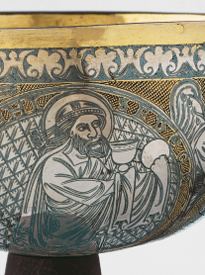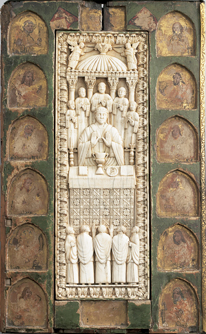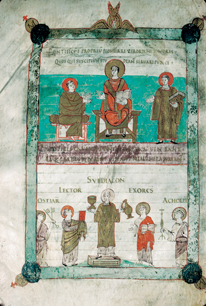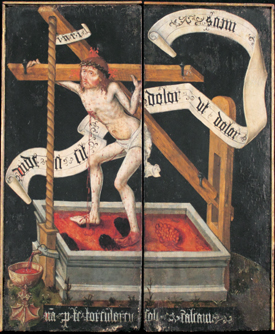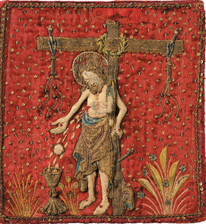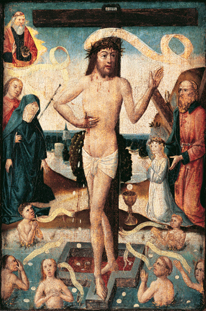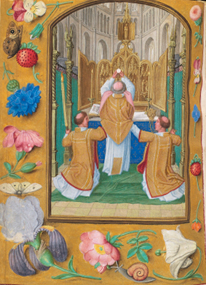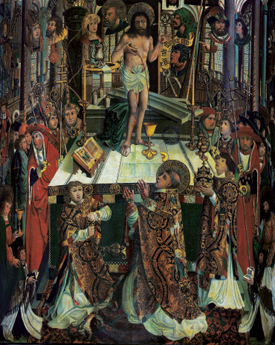30 May – 18 August 2013
»trotz Natur und Augenschein«
Faith, the law of sight transcending
The Eucharist - Transformation and Worldview. On the occasion of the »Eucharistic Congress« (www.eucharistie2013.de), Kolumba, the art museum of the Cologne Archdiocese, is presenting from Corpus Christi Day to Assumption Day a special exhibition with international loans of superb quality. The exhibition expands the context of the 6th annual exhibition called »Art is Liturgy«, which contains works from the museum's own collection. - »Doth it pass thy comprehending? /Faith, the law of sight transcending / Leaps to things not understood« With this verse, theologian Thomas of Aquinas (1225-1274) described the mystery of the transubstantiation of bread and wine to the body and blood of Christ as the central element of the Eucharistic celebration. The earthly and the heavenly are united, and the visible bread and wine transform into the invisible body of Christ. It was precisely this invisibility that, since the early Middle Ages, has provoked translation into visible images, which have fulfilled a central artistic and theological function as adornments of ecclesiastical writings, utensils and rooms. The struggle for creating images of a seemingly unfeasible vision portraying the Son of God as THE salvation meal, largely forgotten today - this is what the exhibition is all about. After several years of research, it has been possible to procure specifically pinpointed loans from museums, libraries and church treasuries not only in Germany, but also from elsewhere in Europe, most notably the Biblioteca Apostolica Vaticana, the Bibliothèque nationale in Paris, the Bayerische Staatsbibliothek in Munich and the Staatsbibliothek in Berlin as well as the British Museum in London, and last but not least, from church parishes and - with two large panel paintings - from Erfurt Cathedral. The time period covered by the exhibition extends from the modest beginnings in the 8th century, when images were slowly beginning to gain acceptance despite being banned, up to the excessive flood of images during the fight for the true faith in the late Middle Ages, shortly before the Reformation. During Carolingian and Ottonian times, the emphasis was on the standardization and confirmation of the rite, altered in accordance with Roman models. Parallel to this, a canon of motifs developed, which described the process of transubstantiation using historical, typological, and poetic motifs. With the introduction of the Feast of Corpus Christi, the types of images chosen change in the 13th century. They become more narrative, more physical, and more public in nature. Whereas initially, they were only meant for the eyes of the clerics, the Eucharistic portrayals now leave the narrow focus on the lavishly adorned missals and utensils. They enter the iconographic programs for large altarpieces, books of hours, manuscripts for private devotion, and serve as a profession of the true faith on the epitaphs of the deceased. In the late Middle Ages, the Eucharist as the central sacrament of religious self-understanding is at the center of completely new, often allegorical, image inventions containing numerous hidden theological programs.
German book publication: Edited by Ulrike Surmann and Johannes Schröer with a salutatory message by Joachim Cardinal Meisner, an introduction, as well as 11 theological and art historical essays and 6 literary articles by renowned writers; numerous color reproductions, 376 pages, format 17x24cm, stitched binding, hardcover, Greven-Verlag, Cologne, € 24.80
Loans by:
Alunda, Ev. Kirchengemeinde, Erzbistum Uppsala
Autun,Bibliothèque municipale
Bergamo, Museo e Tesoro della Cattedrale
Berlin, Staatsbibliothek – Preußischer Kulturbesitz
Cambridge, The Fitzwilliam Museum
Colmar, Bibliotèque municipale
Erfurt, Katholische Kirchengemeinde St. Marien - St. Severi
Frankfurt a.M., Liebieghaus Skulpturensammlung
Gronau,Evangelische Pfarrgemeinde S. Matthäi
Hannover, Museum August Kestner
Hildesheim, Dombibliothek
Hildesheim, Dom-Museum
Kassel, Universitätsbibliothek, Landesbibliothek u. Murhardsche Bibliothek
Koblenz, Mittelrhein-Museum
Köln, Erzbischöfliche Diözesan- und Dombibliothek
Köln, Wallraf-Richartz-Museum
London, The British Museum
München, Bayerische Staatsbibliothek
Nördlingen, Stadtmuseum
Nürnberg, Germanisches Nationalmuseum
Paderborn, Erzbischöfliche Akademische Bibliothek
Paris, Bibliotèque nationale de France
Paris, Musée du Louvre
Rathenow, Evangelische Pfarrgemeinde St. Marien-St. Andreas
Rom, Biblioteca Apostolica Vaticana
Segovia, Museo Catedralico
Siegburg, Katholische Kirchengemeinde St. Servatius
Soest, Evangelische Pfarrgemeinde St. Petri-Pauli
Werben, Evangelische Kirchengemeinde St. Johannis
German book publication: Edited by Ulrike Surmann and Johannes Schröer with a salutatory message by Joachim Cardinal Meisner, an introduction, as well as 11 theological and art historical essays and 6 literary articles by renowned writers; numerous color reproductions, 376 pages, format 17x24cm, stitched binding, hardcover, Greven-Verlag, Cologne, € 24.80
Loans by:
Alunda, Ev. Kirchengemeinde, Erzbistum Uppsala
Autun,Bibliothèque municipale
Bergamo, Museo e Tesoro della Cattedrale
Berlin, Staatsbibliothek – Preußischer Kulturbesitz
Cambridge, The Fitzwilliam Museum
Colmar, Bibliotèque municipale
Erfurt, Katholische Kirchengemeinde St. Marien - St. Severi
Frankfurt a.M., Liebieghaus Skulpturensammlung
Gronau,Evangelische Pfarrgemeinde S. Matthäi
Hannover, Museum August Kestner
Hildesheim, Dombibliothek
Hildesheim, Dom-Museum
Kassel, Universitätsbibliothek, Landesbibliothek u. Murhardsche Bibliothek
Koblenz, Mittelrhein-Museum
Köln, Erzbischöfliche Diözesan- und Dombibliothek
Köln, Wallraf-Richartz-Museum
London, The British Museum
München, Bayerische Staatsbibliothek
Nördlingen, Stadtmuseum
Nürnberg, Germanisches Nationalmuseum
Paderborn, Erzbischöfliche Akademische Bibliothek
Paris, Bibliotèque nationale de France
Paris, Musée du Louvre
Rathenow, Evangelische Pfarrgemeinde St. Marien-St. Andreas
Rom, Biblioteca Apostolica Vaticana
Segovia, Museo Catedralico
Siegburg, Katholische Kirchengemeinde St. Servatius
Soest, Evangelische Pfarrgemeinde St. Petri-Pauli
Werben, Evangelische Kirchengemeinde St. Johannis
